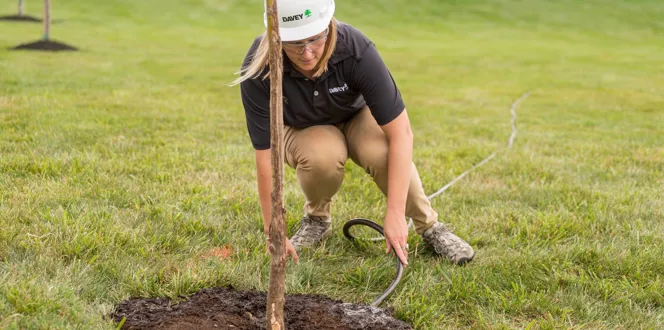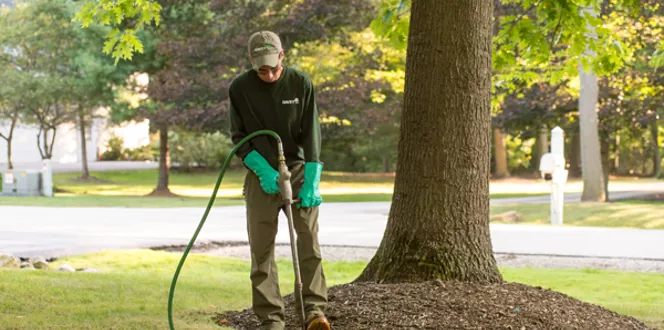California’s drought epidemic killed more than 12 million trees from 2011 to 2015. The perpetual heat and lack of rain continuously caused trees to die in California’s national parks. Eventually, it also started affecting the landscape of urban parks, tree-lined streets, and neighborhoods.
Learn how to monitor your trees during drought below.
Len Burkhart, a Davey Institute technical advisor based in California, shares signs of drought and solutions to protect our most valuable natural assets—trees.
Here are some of his tips to detect whether your trees are being affected by this on-going dry spell.
Look Out For These Drought Signs
- Leaf loss
- Leaf wilt or leaves that start to curl
- Scorched, gray-tinted leaves
- Thinning canopy
- Branches drying out and dying
- Wood-boring insects
- Pine tree discoloration: Pines turn grayish-green color and then turn into rust once dead.
10 Steps You Should Take If You Notice Signs of Drought In Your Trees
- Follow all water rules and regulations. Know watering regulations set by your community, water provider and/or water district during drought season. Be conscious and considerate of these watering rules.
- Be water-wise. Do not use excess water during a drought. Know how much water your trees and landscape need to survive and water accordingly. Water using 5 to 20 gallons, depending on the tree species, once or twice a week.
- *Watering tip for clay-based soil: Dig approximately 4 to 6 inches into the ground near one of your trees after watering. Form a ball of dirt in your hand. If water squeezes out, you watered too much. You should not have mud residue on your hand.
- Water at the right time. Water between 6 p.m. and 10 a.m. in order to maximize water’s effectiveness. Watering during the day allows for quicker evaporation, minimizing the amount of water that gets to your roots.
- Utilize mulch. Mulch preserves moisture in the tree roots and alleviates soil surface water evaporation. Use correct mulching techniques to combat disease and infestation.
- Water newly planted trees first. New plants and trees in your landscape require more water than mature plants. Sustain new plants while caring for the old in order to create lasting impressions with your landscape.
- Delay further planting until fall. Hold off planting new trees and plants in your landscape—to conserve natural resources. Reassess drought conditions in the fall for future plantings.
- Invest in rain barrels. Use rain barrels in and outside your home to collect excess water. Use rain barrels indoors to gather water from leaky faucets or drains, and use barrels outside to collect rainfall and dew.
- Re-use recycled water or gray-water. We use water every day for numerous activities from showering to washing our clothes and dishes. You can save surplus water or “gray water” from sinks, showers, tubs and washing machines by installing various filtering systems.
- Inspect irrigation systems. Burkhart recommends checking your irrigation system once a month for blockage and breaks. Make sure when watering plants that the water doesn’t hit trunks or stems of the trees and plants. That increases the chance of trunk cankers and root-rot diseases. Also, remember to put the water where the roots are.
- Create drought-prone (or drought-resistant) landscapes. Make sure to research trees and plants that are native to your climate before planting. Drought-prone trees and plants will save you water and stay alive longer—creating lasting benefits.
What NOT to Do During a Drought
- Water hardscapes
- Fertilize
- Water on windy or rainy days
- Over-water
- Use water with high salt content
- Water the trunk of trees, which may cause trunk cankers or lead to root-rot diseases.
For more information about drought tree and landscape care, check out Colorado State University’s Watering a Home Landscape During Drought article.





